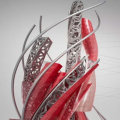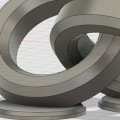Polypropylene is an important material used in many industrial and consumer products. From packaging to automotive components, it is a versatile and durable material with a range of properties that makes it suitable for many applications. This article provides a comprehensive overview of the properties and uses of polypropylene, as well as its advantages and disadvantages. Whether you are a manufacturer looking for a material to produce your products or just curious about what polypropylene is, this article will provide you with a better understanding of this popular material. Polypropylene is a type of thermoplastic polymer commonly used in large format printing, films and adhesives.
It offers a range of advantages over other materials, including excellent chemical resistance, high strength and stiffness, excellent temperature range, and low cost. In this article, we will provide an comprehensive overview of polypropylene, its properties, uses, production process and environmental impact.
Properties of polypropylene:
Polypropylene has a unique combination of properties that make it suitable for many applications. It has excellent tensile strength and stiffness, making it ideal for use in adhesives and films. It has an impressive temperature range, from -100°F to +350°F (-73°C to +177°C).This makes it suitable for use in a variety of climates. Additionally, polypropylene is highly resistant to chemicals and corrosion.
Uses of polypropylene:
Polypropylene is commonly used in large format printing, films and adhesives. It is often used as a substrate for inkjet printing, as it provides good ink adhesion and superior resistance to moisture. It is also used as a mounting film for digital prints, as it offers high strength and rigidity.Additionally, it is often used in adhesive labels and tapes due to its excellent chemical resistance.
Production process:
Polypropylene is produced using a polymerization process, which involves the combination of propylene monomers. This process typically takes place in reactors at high temperatures and pressures. The resulting polymer is then extruded into pellets that can be molded into desired shapes. The pellets are then dried and cooled before they are ready to be used in production.Advantages and disadvantages:
Polypropylene has several advantages compared to other materials used in large format printing, films and adhesives.These include its excellent chemical resistance, high strength and stiffness, wide temperature range, and low cost. However, there are some drawbacks to using polypropylene. For example, it can be difficult to bond to some other materials due to its low surface energy.
Environmental impact:
The production of polypropylene results in the release of volatile organic compounds (VOCs) into the atmosphere. Additionally, the disposal of polypropylene products may also result in the release of VOCs into the environment.To minimize the environmental impacts of producing and using polypropylene, manufacturers should use recycled materials or look for ways to reduce their VOC emissions.
Advantages and Disadvantages
Polypropylene offers many advantages when used for large format printing, films and adhesives. Its chemical resistance makes it an ideal choice for a variety of applications, such as food packaging and chemical storage. It also has excellent temperature range, high strength and stiffness, and low cost. However, polypropylene also has some disadvantages that should be considered before using it.It is not as heat resistant as other materials, which can limit its use in high temperature applications. Additionally, it is not UV stable and will degrade over time when exposed to direct sunlight. Overall, polypropylene is an excellent choice for many applications due to its excellent chemical resistance, strength and stiffness, temperature range and low cost. However, users should be aware of its limitations, such as its lack of heat resistance and UV stability.
Environmental Impact
Polypropylene is generally considered to be a safe and environmentally friendly material.It is non-toxic, non-allergenic, and non-irritating, making it suitable for many applications. It can also be recycled, although the exact process may vary depending on the type of polypropylene. In addition, polypropylene is an energy-efficient material, requiring less energy to process than many other materials. This means that using polypropylene can help to reduce carbon emissions. The main environmental concern with polypropylene is the waste generated during its production. Most polypropylene products are not biodegradable and therefore require special disposal methods.
It is important to research the correct disposal methods for any polypropylene materials that you may use.
Overall, polypropylene can be a beneficial material with minimal environmental impact.
Production Process
Polypropylene is produced through a process known as polymerization, which involves combining propylene molecules with other molecules such as ethylene and butadiene. The result is a polyolefin, which is then put through a process of extrusion. This produces a polypropylene resin that is then used to create various products. The production process also involves adding a variety of additives and fillers such as dyes, pigments, and stabilizers to create a variety of colors and textures.These additives can also be used to enhance the properties of the polypropylene, such as heat resistance or UV protection. The production process for polypropylene can vary depending on the type of product being created. Generally, it involves melting the resin and then molding it into the desired shape. For example, when producing films and adhesives, the resin is heated and then extruded through a die to form the desired shape.
Once the desired product is formed, it is cooled and then cured, which helps to improve its strength and durability. After curing, the product is ready for use.
Polypropylene
, production process, polymerization, extrusion, additives, fillers, molding, curing.Properties of Polypropylene
Polypropylene has many unique and advantageous properties that make it a popular choice for large format printing, films and adhesives.Its chemical resistance and strength make it an ideal material for a variety of applications. Furthermore, it has excellent temperature range and low cost. Here are some of the key properties of polypropylene:Chemical Resistance:Polypropylene offers excellent chemical resistance, meaning it is resistant to most chemicals and solvents. This makes it ideal for use in the production of films and adhesives.
High Strength and Stiffness:
Polypropylene is a strong and stiff material, making it an ideal choice for applications where high strength and stiffness are required.Excellent Temperature Range:
Polypropylene has a wide temperature range, meaning it can be used in a variety of climates.Its low thermal expansion also makes it suitable for use in extreme temperatures.
Low Cost:
Polypropylene is a cost-effective material, making it an ideal choice for large format printing, films and adhesives.Uses of Polypropylene
Polypropylene has many uses in large format printing, films and adhesives. It is often used as an alternative to other materials, as it offers a range of advantages, such as excellent chemical resistance, high strength and stiffness, wide temperature range and low cost. In the packaging industry, polypropylene is used to make containers, bottles, bags and films. It is commonly used to manufacture food packaging, such as microwavable trays, due to its resistance to high temperatures.Polypropylene is also used to make labels for bottles and cans, and shrink wrap for palletized products. In the textile industry, polypropylene is used to make carpets, ropes, industrial fabrics and geotextiles. It is often used in the production of non-woven fabrics due to its high strength and low cost. In addition, it is also used to make protective clothing, such as flame-retardant fabric.
In the automotive industry, polypropylene is used to make car components, such as bumpers and fenders. It is also used in the production of car seat covers, as it is resistant to abrasion and moisture. Polypropylene can also be used to manufacture car interior components such as door panels and dashboard covers. Polypropylene is also commonly used in the production of medical devices.
It is often used to make syringes, catheters, implants and surgical sutures due to its excellent chemical resistance and thermal stability. Additionally, it is also used for drug delivery systems, such as intravenous bags and infusion pumps. In conclusion, this article has provided an in-depth overview of polypropylene and its many advantages for use in large format printing, films and adhesives. With its excellent chemical resistance, high strength and stiffness, excellent temperature range and low cost, it is a versatile material that can be used in a wide range of applications. It is important to understand the properties and uses of polypropylene to make the most of its advantages.











Leave Message